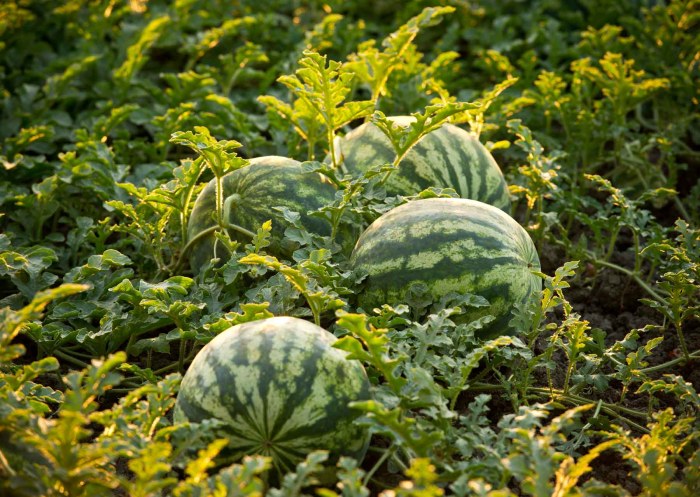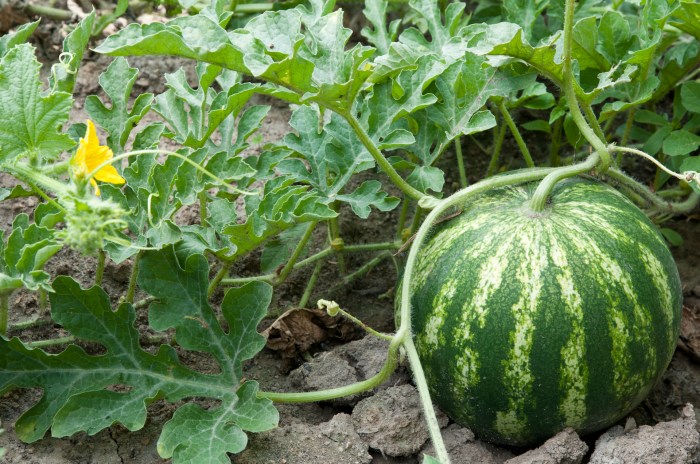Preparing the Planting Site

How to plant watermelon seed – A sun-drenched field, a canvas brown and bare, awaits the tender touch of life, a hopeful, fragile prayer. The earth, a somber, silent keeper of the past, holds secrets whispered low, its future overcast. Yet, in its depths, a promise sleeps, a vibrant, juicy dream, of sweet reward, while sorrow weeps, a silent, mournful stream.
Watermelons, sun-worshippers of summer’s golden grace, demand a soil both rich and deep, a nurturing embrace. Proper preparation lays the groundwork for their growth, a testament to patient care, a love that knows no sloth.
Ideal Soil Conditions for Watermelon Cultivation, How to plant watermelon seed
The soil, a canvas for this sun-kissed vine, must offer fertile ground, a haven truly fine. A slightly acidic pH, a range from 6.0 to 6.8, ensures the nutrients flow, preventing nature’s sway. Excellent drainage is key, lest roots in water drown, a somber, silent symphony, a harvest lost and down. Abundant sunlight, at least six hours a day, fuels the plant’s sweet energy, chasing gloom away.
Planting watermelon seeds involves choosing a sunny spot and preparing well-drained soil. Timing is crucial, much like understanding when to plant other species; for instance, knowing the ideal time to plant a magnolia tree is essential for its success, which you can learn more about at magnolia tree when to plant. Similarly, ensuring your watermelon seeds are planted at the right time, after the last frost, will contribute to a bountiful harvest.
Soil Preparation: Tilling, Amending, and Fertilization
The barren land, a stage set for a play, requires a careful hand, to chase the dark away. First, till the soil to loosen it, a depth of twelve to eighteen inches, releasing nutrients within, where life’s potential winces. Then, amend the earth with compost rich and deep, a nourishing embrace, secrets it will keep. This dark, organic matter, adds life to the tired ground, a gift from nature’s hand, where sweet rewards are found.
Finally, a balanced fertilizer, a measured, careful blend, provides the nutrients needed, until the very end. A slow-release formula, is best to gently feed, ensuring steady growth, fulfilling nature’s creed.
Constructing a Raised Bed for Watermelons
A raised bed, a structured haven, offers control and might, a refuge from the chilling winds, a beacon shining bright. Building one provides the ideal environment for these sun-loving plants, a carefully crafted space where nature’s art expands.
First, choose a sunny location, a space where sunbeams play, then construct a frame of wood, sturdy and strong and gay. Fill the bed with a mixture of topsoil, compost, and sand, a carefully balanced blend, guided by nature’s hand. Ensure proper drainage, with holes in the bed’s base, preventing waterlogging, a sorrowful, watery waste. Once the bed is prepared, the seeds can then be sown, a hopeful, gentle act, a future brightly shown.
Sowing Watermelon Seeds

A sun-drenched field, a hopeful heart, a tiny seed—a fragile promise whispered on the breeze. The act of planting, a melancholic dance between anticipation and the unknown, a surrender to the whims of nature’s gentle hand. We sow not only seeds, but dreams, fragile as the tendrils of a newborn vine.
Watermelon seeds, small vessels of summer’s sweetness, require careful handling to ensure a bountiful harvest. The method of sowing depends on your climate and personal preference, each approach a subtle variation on the same hopeful theme.
Direct Sowing
Direct sowing, a method favored by those who embrace the immediacy of nature’s rhythm, involves planting seeds directly into the prepared soil. This approach allows the roots to establish themselves undisturbed, minimizing transplant shock. Planting depth should be approximately one inch, with seeds spaced about 2 to 3 feet apart to allow for ample growth. Gently cover the seeds with soil, firming it lightly to ensure good contact, and water thoroughly but gently, avoiding erosion.
The earth drinks deeply, mirroring the thirst of our own longing for fruition.
Starting Seeds Indoors
For those who seek to hasten the process or are planting in a shorter growing season, starting seeds indoors offers a measure of control. Seeds are sown in small pots or seed trays filled with a well-draining seed-starting mix, at a depth of about half an inch. Maintain consistently moist soil and a warm environment (around 70-80°F), and thin seedlings to the strongest once they develop their first true leaves.
The delicate seedlings, fragile as newborn hope, yearn for the sun’s embrace. Transplanting outdoors should occur after the last frost, once the soil has warmed.
Optimal Planting Depth and Spacing
The depth and spacing of watermelon seeds are crucial factors in their successful germination and growth. Planting too deeply can hinder emergence, while planting too shallowly leaves them vulnerable to the elements. Similarly, overcrowding deprives plants of essential resources, resulting in smaller, less productive vines. The precise spacing depends on the variety, but a general guideline is to space seeds 2 to 3 feet apart within the row and 4 to 6 feet between rows, ensuring each plant has sufficient space to develop its sprawling tendrils.
The rows, like lines etched in time, mark our patient journey toward harvest.
Planting Technique
The act of planting is a quiet ritual, a moment of connection between human hand and the earth’s generous embrace. Create a small hole with your finger or a small trowel, place the seed at the desired depth, cover it gently with soil, and firm the soil around it. Water gently but thoroughly, ensuring the soil is moist but not waterlogged.
Each seed placed, a whispered prayer for a bountiful yield.
Common Mistakes to Avoid
The path to harvest is often fraught with pitfalls, and even the most seasoned gardener can stumble. Planting too deeply, failing to provide adequate spacing, inconsistent watering, and neglecting soil preparation are among the most frequent mistakes. The unforgiving earth offers a harsh lesson, a reminder of our own mortality and the ephemeral nature of all things. Remember, patience and careful observation are key.
Watermelon Seed Germination and Early Growth: How To Plant Watermelon Seed
A fragile hope, a tiny seed, buried deep in earth’s embrace, dreams of sun-drenched fields and juicy, sweet reward. But the journey from slumber to verdant life is fraught with peril, a delicate dance between warmth, moisture, and the unseen threats that lurk beneath the soil. The germination of a watermelon seed, a poignant metaphor for life’s own fragile beginnings, demands careful attention and a tender hand.Ideal conditions for this nascent life are a symphony of warmth and humidity.
The soil, a nurturing mother, must cradle the seed in temperatures between 70 and 85 degrees Fahrenheit (21 and 29 degrees Celsius). A consistently moist, yet not waterlogged, environment is crucial. Think of a gentle rain, not a deluge, sustaining the seedling’s thirst. Humidity levels around 70% provide the ideal atmospheric conditions for the seed to break its slumber and unfurl its tender leaves.
Successful Germination and Early Seedling Growth
The emergence of the watermelon seedling is a momentous occasion. First, a tiny root, a lifeline to the earth, pushes downwards, anchoring the plant. Then, a pale green shoot, a fragile arrow pointing towards the sun, bravely breaks the surface. The cotyledons, the seed leaves, unfurl, providing the seedling with initial nourishment. True leaves soon follow, a vibrant green testament to the success of the germination process.
Healthy seedlings exhibit vigorous growth, their stems sturdy and their leaves unblemished. A slow, stunted growth, on the other hand, suggests underlying problems.
Problems Hindering Germination and Early Growth
Alas, the path to fruition is not always smooth. Pests, like aphids or flea beetles, can feast on tender leaves, stunting growth or even killing the seedling. Fungal diseases, thriving in damp conditions, can rot the seeds or young roots before they even have a chance to flourish. Insufficient watering leads to desiccation, while overwatering drowns the roots, suffocating the nascent life.
The delicate balance between nurturing care and neglect is a constant struggle. A farmer’s heart aches with each lost seedling, a silent testament to the unpredictable nature of life itself.
Protecting Seedlings from Frost or Harsh Weather
The young watermelon plant, so vulnerable in its infancy, is easily harmed by frost or harsh weather conditions. A sudden drop in temperature can cause irreparable damage, turning vibrant green leaves to blackened, withered husks. Protecting these fragile lives requires vigilance. Row covers, lightweight fabrics draped over the seedlings, act as a shield against the cold, creating a microclimate of warmth and protection.
For more severe conditions, consider individual cloches or even a small greenhouse, providing a sanctuary from the elements. The farmer’s dedication, a constant battle against the whims of nature, is a testament to the enduring human spirit.
Troubleshooting Common Problems

The sun-scorched earth, a canvas of cracked soil, reflects the silent struggle of the watermelon vine. A fragile life, clinging to the promise of sweet, juicy fruit, yet threatened by unseen foes. The gardener’s heart aches with the weight of potential loss, a melancholic symphony played out in the parched fields.The tender shoots, once vibrant green, now bear the marks of disease and pest infestation, a silent testament to the harsh realities of nature’s capricious dance.
Understanding these threats is the first step towards preserving the harvest, a poignant act of nurturing against the odds.
Watermelon Diseases and Pests
A tapestry of woes weaves its way through the watermelon patch. Fungal infections, viral attacks, and the relentless gnawing of insects all contribute to the decline of the precious plants. Early detection and swift intervention are crucial to mitigating the damage, a battle fought with knowledge and careful attention. The gardener’s vigilance becomes a lifeline, a desperate hope against the encroaching darkness.
Disease Symptoms and Treatments
The wilting leaves, a pale reflection of their former glory, whisper tales of fungal blight. Powdery mildew, a ghostly coating, stifles the plant’s growth. Anthracnose, with its characteristic lesions, leaves its mark on the fruit itself. Viral infections, often transmitted by aphids, cause mosaic patterns on the leaves, a tragic distortion of nature’s beauty. Treatment involves fungicides, careful sanitation, and resistant varieties—a valiant effort to restore balance.
Pest Identification and Control
Aphids, tiny vampires sucking the life from the tender leaves, congregate in colonies, leaving behind a sticky residue. Squash bugs, with their piercing mouthparts, inflict irreparable damage. Cutworms, unseen architects of destruction, sever the stems at ground level, leaving behind a trail of devastation. Integrated pest management strategies, including biological controls and judicious pesticide use, are vital in this silent war against the invaders.
Each lost plant feels like a personal loss, a poignant reminder of nature’s fragility.
| Problem | Symptoms | Cause | Solution |
|---|---|---|---|
| Fusarium Wilt | Wilting, yellowing leaves, stunted growth | Fusarium oxysporum fungus | Use resistant varieties, crop rotation, soil solarization |
| Anthracnose | Lesions on leaves, stems, and fruit | Colletotrichum lagenarium fungus | Fungicide application, seed treatment, resistant varieties |
| Powdery Mildew | White powdery coating on leaves | Podosphaera xanthii fungus | Fungicide application, good air circulation |
| Aphids | Curled leaves, sticky residue, stunted growth | Aphids | Insecticidal soap, beneficial insects (ladybugs) |
| Squash Bugs | Wilting, yellowing leaves, stunted growth | Squash bugs | Handpicking, insecticidal soap, row covers |
FAQ Section
Can I grow watermelon in pots?
Yes, but choose a large pot (at least 18 inches in diameter) and ensure adequate drainage. Bush varieties are better suited for container gardening.
When is the best time to plant watermelon seeds?
After the last frost, when soil temperatures consistently reach 70-80°F (21-27°C).
How often should I water my watermelon plants?
Water deeply and regularly, especially during dry periods, aiming for consistently moist but not waterlogged soil. Reduce watering as the fruit matures.
What should I do if my watermelon plants show signs of yellowing leaves?
Yellowing leaves can indicate nutrient deficiencies (especially nitrogen) or overwatering. Adjust your watering and consider adding a balanced fertilizer.

